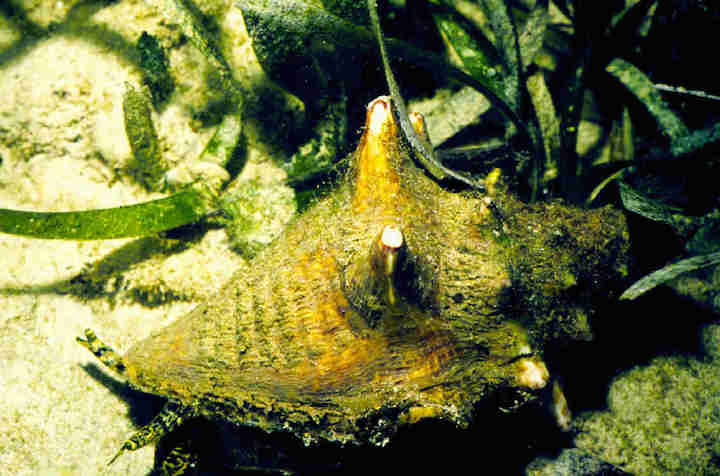
Shedd Aquarium photo of a Queen Conch grass bed
|
New Study Shows a Caribbean Queen Conch Population is Slowly Dying of Old Age Within a Marine Sanctuary
CHICAGO –
The queen conch
is an
iconic Caribbean marine snail whose populations have declined
significantly over the last two decades due to overfishing. Even when
individual populations are well-protected within marine sanctuaries,
their long-term viability may be in doubt, according to a new study published at the end of
June in the journal
Marine Ecology Progress Series.
The study suggests that a network of connected marine parks would better protect conch into the future.
Researchers from
Shedd Aquarium, University of Miami and
Community Conch studied protected queen conch,
Lobatus gigas, within the Exuma Cays Land and Sea Park (ECLSP). Established in 1958, the ECLSP was the
first Marine Protected Area (MPA)
created
in the wider Caribbean and is famous for its pristine environments.
While it bans fishing, shelling, conching and lobstering within its
borders, and protects various habitats from seagrass and mangroves to
coral reefs and stromatolites, recent surveys and
historical data suggest its conch population may be in trouble. While
individual animals are living to older ages, new generations of conch
are less prevalent and the average age of the population has been
increasing for decades.
“The
queen conch is considered a national conservation concern in The
Bahamas as a popular culinary staple and valuable export commodity and
thus, the people and government have taken steps to protect
them,” said Dr. Andy Kough,
postdoctoral researcher
at Shedd Aquarium who led the study. “However, our research serves as a
reminder that not all protected populations are self-replenishing and
that the success of a MPA can depend on processes outside of its
borders. These results demonstrate the importance
of continued monitoring to assess MPA efficacy and show how the biology
of a species inherently affects its distribution in the oceans.”
Researchers
collected data describing conch abundance and age. To measure
abundance, researchers used tow-boards to conduct visual surveys of
conch while being towed behind small boats. In addition
to visual surveys, researchers measured the population’s relative age
by free-diving to the seafloor and bringing conch aboard their boat.
There, they measured the length and lip thickness of the conch before
returning them to the ocean. By comparing surveys
with 22 years of historical data, the study authors were able to track
how the population is doing and showed that the average age is
increasing.
“In
theory, effective MPAs preserve an ecosystem by reducing human-related
impacts from affecting the species within its borders,” Kough added.
“Species within an MPA should thrive, spill over and
replenish the unprotected areas surrounding it, anchoring the ecosystem
as a whole. However, it is challenging to protect animals with complex
lifecycles, especially in marine species like the queen conch, because
most have a free-floating larval stage that
can last for weeks to months. As such, animals transitioning from
larvae to a juvenile are often a long distance away from where life
began because of ocean currents and tidal cycles. The park is home to
the highest abundance of conch in the Exumas because
of the diligent work of the park staff, but without larvae from
populations outside of the protected area it may dwindle and disappear.”
By
nature, a conch is a slow-moving snail that does not move large
distances as an adult. When it comes to breeding, this means the animal
is more likely to find a mate in a location with high densities
of other conchs. Areas with fewer conchs have little to no breeding and
must rely on other areas to replenish the population and supply the
next generation. If the source of larvae is missing, even a very
well-protected population, like the ECLSP, may slowly
die off.
The Bahamas National Trust has
launched a national “Conchservation”
campaign with conservation partners, including Shedd Aquarium, aimed at
protecting queen conch in The Bahamas through research, citizen science
and policy change.
The plight of the conch has even inspired Bahamian artists to
record a song and produce a music video.
“As
conservation efforts continue in The Bahamas, Shedd looks forward to
monitoring conch within the ECLSP and throughout The Bahamas in order to
help inform a science-based management policy for
the species,” said Kough.
For more information about Shedd Aquarium’s research on queen conch,
visit Shedd Aquarium’s website.
